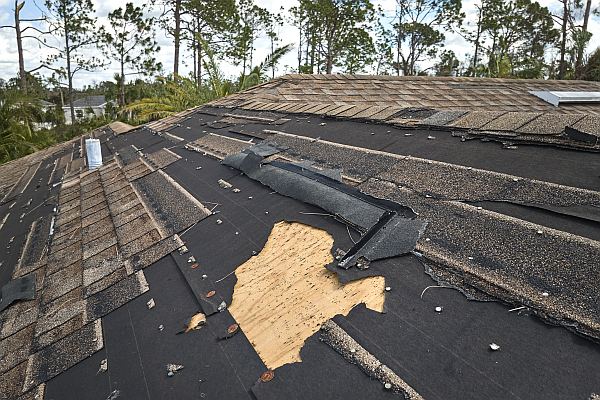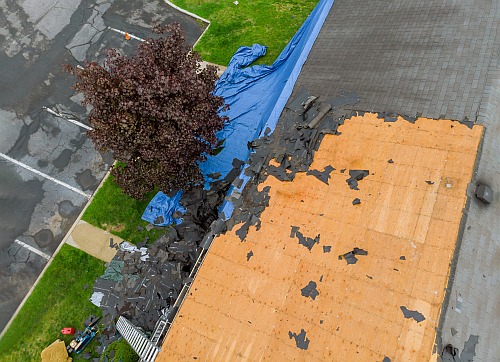Storms can be unpredictable and destructive, leaving behind damage to your property that may take time and money to repair. As a homeowner, protecting your roof against storm damage is crucial in maintaining the integrity of your home’s structure.
From installing impact-resistant roofing materials to trimming trees near your roof, you can take several proactive steps to safeguard against storms. In this blog post, we’ll share our top tips for protecting your roof from damage during a storm so that you can rest easy knowing that you’ve taken all the necessary precautions.
Install Impact-Resistant Roofing Materials
Installing impact-resistant roofing materials is one of the most proactive steps to protect your roof from storm damage. Impact-resistant materials, such as shingles made of metal or asphalt, are designed to withstand high winds and hail storms. These materials are tested rigorously and can provide superior protection against weather-related damage.
Impact-resistant shingles come in various styles and colors that will complement the exterior design of your home. Some homeowners may be hesitant to invest in impact-resistant roofing due to its higher cost compared to traditional roofing materials. However, it’s essential to consider the long-term benefits that this investment can bring; installing impact-resistant roofing can save time and money on repairs after a severe storm.
When considering an upgrade to impact-resistant roofing, it’s crucial to work with a professional roofer with experience installing these products. They’ll help you understand the features and benefits of each material type so that you can make an informed decision about which option is best for your specific needs.
Clean Gutters and Downspouts
One of the most important things you can do to protect your roof during a storm is to clean your gutters and downspouts. Gutters and downspouts are responsible for directing water away from your roof, preventing water damage or leaks.
Over time, leaves, branches, and other debris can accumulate in your gutters and downspouts. When this happens, it can prevent water from flowing properly through them. Heavy rainfall during a storm and the water cannot flow through the gutters or downspouts as intended could back onto your roof, causing potential harm.
To avoid such problems, you should regularly inspect and clean out any debris that may have accumulated in these areas. Depending on where you live or how many trees surround your property determines how often cleaning needs to be done – at least twice a year is recommended.
If cleaning out gutters seems too daunting of a task for you, then it’s worth hiring professional help instead of ignoring its importance altogether. Clear pathways for rainwater will allow it to flow easily into the designated drainage area rather than sitting stagnant on top of roofs, potentially leading to severe damage later on.
Secure Loose Objects Around Your Property
When a storm hits, it’s not just your roof that can sustain damage. Loose objects around your property can also become dangerous projectiles, causing harm to people and property alike. That’s why securing anything that strong winds could pick up is crucial.
Start by walking around your home’s perimeter and identifying any loose items, such as patio furniture, planters, or toys. These should all be brought inside or secured with sandbags or weights.
If you have trees on your property, check for any dead branches that could break off during a storm and cause damage to your roof or windows. Trim these back so they don’t pose a threat.
Don’t forget about items stored in outdoor sheds or garages! Ensure these structures are securely fastened down and aren’t vulnerable to being tipped over by high winds.
Clean Gutters and Downspouts
One of the most important things you can do to protect your roof against storm damage is to regularly clean your gutters and downspouts. When debris, such as leaves, twigs, and dirt, accumulate in your gutters, they can clog up the water flow, causing it to pool on your roof. This can lead to water damage and leaks which weaken the integrity of your roof.
To prevent this from happening, clean out your gutters at least twice a year or more often, if necessary, depending on where you live. You should also check for any cracks or damages that may need repair.
Additionally, it’s important to ensure the downspouts are clear so water flows away from your home effectively. Clearing these regularly will help avoid drainage issues around your home’s base, which could cause flooding and other problems.
Inspect Your Roof Regularly
Regular roof inspections are crucial to protect your home from storm damage. Inspecting your roof at least twice a year can help detect potential issues before they become bigger problems.
During an inspection, pay close attention to missing or damaged shingles, cracks in the caulking around vents and chimneys, and signs of wear and tear on flashing. Check for areas where water may be pooling or where debris has accumulated.
If you notice any issues during your inspection, address them as soon as possible. Small repairs now can prevent larger expenses down the line.
For those not comfortable climbing onto their roof, consider hiring a professional roofing company like Atalanta Roofing to perform regular inspections. They have experience identifying potential problem areas that may go unnoticed by an untrained eye.
Trim Trees and Branches Near Your Roof
Trimming trees and branches near your roof is essential to protect it from storm damage. Overhanging tree limbs can scrape against your roof during high winds, causing shingles to lift or tear off completely.
Additionally, if a large branch were to fall onto your roof during a storm, it could cause significant damage that may result in costly repairs. By trimming back any overgrown trees or branches around your home, you can help prevent these types of incidents from occurring.
However, it’s important to note that trimming trees and branches should be done carefully and by a professional if necessary. Trimming large branches alone could be dangerous and cause more harm than good.
To ensure that the job is done right and safely, consider hiring a licensed arborist with experience working with trees near homes. They will have the proper equipment and knowledge needed to complete the job effectively without putting anyone at risk.
Contact Atlanta Roofing For All Your Roofing Needs
By following these tips, you can protect your roof against damage in a storm. Remember to take necessary precautions before the storm hits and be proactive about regularly inspecting and maintaining your roof.
However, if you experience issues with your roof after a storm or any other time, it’s important to contact an experienced roofing company like Atlanta Roofing. Our team of professionals has years of experience working on residential and commercial roofs.
We offer various services, including repair, replacement, maintenance, and installation of roofing materials. You can trust us to provide reliable solutions tailored to your unique needs.
So please don’t wait until it’s too late! Contact Atlanta Roofing today at 404-737-7179 for all your roofing needs. We’ll happily answer any questions and help keep your home or business safe from the next big storm.



